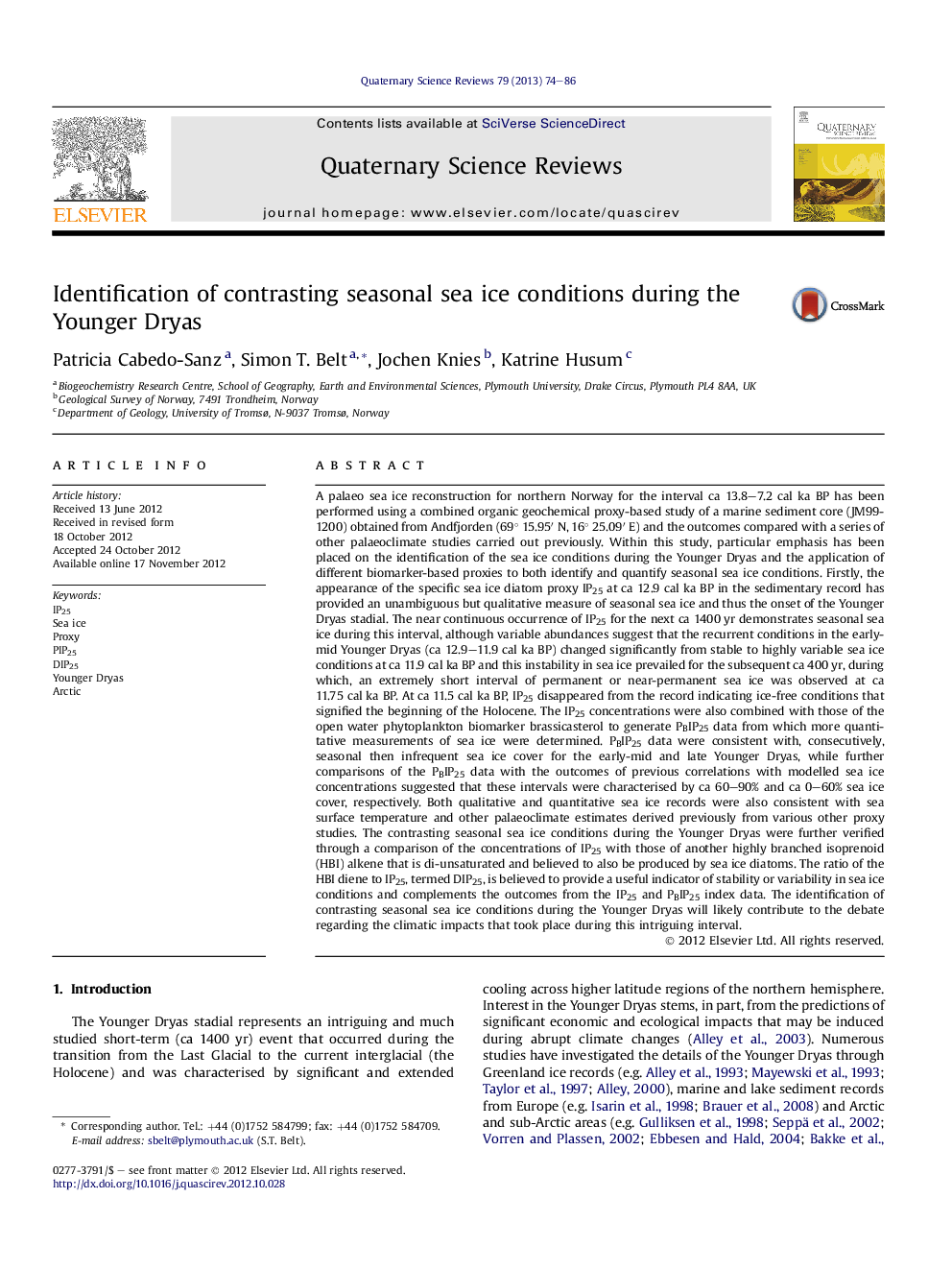| کد مقاله | کد نشریه | سال انتشار | مقاله انگلیسی | نسخه تمام متن |
|---|---|---|---|---|
| 4735488 | 1640855 | 2013 | 13 صفحه PDF | دانلود رایگان |

A palaeo sea ice reconstruction for northern Norway for the interval ca 13.8–7.2 cal ka BP has been performed using a combined organic geochemical proxy-based study of a marine sediment core (JM99-1200) obtained from Andfjorden (69° 15.95′ N, 16° 25.09′ E) and the outcomes compared with a series of other palaeoclimate studies carried out previously. Within this study, particular emphasis has been placed on the identification of the sea ice conditions during the Younger Dryas and the application of different biomarker-based proxies to both identify and quantify seasonal sea ice conditions. Firstly, the appearance of the specific sea ice diatom proxy IP25 at ca 12.9 cal ka BP in the sedimentary record has provided an unambiguous but qualitative measure of seasonal sea ice and thus the onset of the Younger Dryas stadial. The near continuous occurrence of IP25 for the next ca 1400 yr demonstrates seasonal sea ice during this interval, although variable abundances suggest that the recurrent conditions in the early-mid Younger Dryas (ca 12.9–11.9 cal ka BP) changed significantly from stable to highly variable sea ice conditions at ca 11.9 cal ka BP and this instability in sea ice prevailed for the subsequent ca 400 yr, during which, an extremely short interval of permanent or near-permanent sea ice was observed at ca 11.75 cal ka BP. At ca 11.5 cal ka BP, IP25 disappeared from the record indicating ice-free conditions that signified the beginning of the Holocene. The IP25 concentrations were also combined with those of the open water phytoplankton biomarker brassicasterol to generate PBIP25 data from which more quantitative measurements of sea ice were determined. PBIP25 data were consistent with, consecutively, seasonal then infrequent sea ice cover for the early-mid and late Younger Dryas, while further comparisons of the PBIP25 data with the outcomes of previous correlations with modelled sea ice concentrations suggested that these intervals were characterised by ca 60–90% and ca 0–60% sea ice cover, respectively. Both qualitative and quantitative sea ice records were also consistent with sea surface temperature and other palaeoclimate estimates derived previously from various other proxy studies. The contrasting seasonal sea ice conditions during the Younger Dryas were further verified through a comparison of the concentrations of IP25 with those of another highly branched isoprenoid (HBI) alkene that is di-unsaturated and believed to also be produced by sea ice diatoms. The ratio of the HBI diene to IP25, termed DIP25, is believed to provide a useful indicator of stability or variability in sea ice conditions and complements the outcomes from the IP25 and PBIP25 index data. The identification of contrasting seasonal sea ice conditions during the Younger Dryas will likely contribute to the debate regarding the climatic impacts that took place during this intriguing interval.
► IP25 used to identify seasonal sea ice during the Younger Dryas.
► PIP25 and DIP25 indices permit more detailed sea ice conditions to be identified.
► Contrasting sea ice conditions identified between the early-mid and late Younger Dryas.
► Biomarker-based sea ice reconstructions align well with other palaeoclimate proxy data.
Journal: Quaternary Science Reviews - Volume 79, 1 November 2013, Pages 74–86